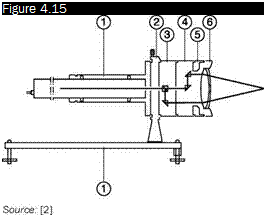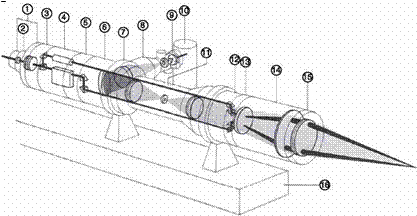Forward-scatter and back-scatter
In the reference beam LDA, the direction of observation is that of the reference beam; in the crossed-beams LDA, this direction is free. Taking the forward-scatter signal (Figure 4.15) by placing the sensor on the opposite side of the light source with respect to the measurement zone, is advantageous in terms of signal strength but is not always possible and/ or convenient:
■ two optical accesses are needed in the test chamber, which is usual in a wind tunnel but can be very difficult in turbomachinery;
■ problems in collimation caused by vibration can arise.
By placing the laser and the sensor together (Figure 4.16) the problem of vibrations is eliminated, as they are treated in the same manner by the laser and by the photomultiplier; but operating in back-scatter, the light
 |
 |
Configuration of a forward-scatter crossed-beams LDA
intensity from the particles is reduced. In the back-scatter configuration the laser power must therefore be increased and/or the two beams can be focused in the measurement volume; with the latter technique, a double benefit is obtained:
 |
■ the measurement volume is smaller: it is possible to get measurements closer to the walls of the model or of the test chamber, preventing strong reflections that can distort the signal detection and damage the opto-electronic instrumentation
■ the contrast between light in the measuring volume and the surrounding region is greater so the signal from the region under investigation will be sharper, and more easily recognizable by spurious signals: ultimately a gain in SNR (signal/noise ratio) is obtained.
The focusing should not be too strong in order to prevent an excessive reduction of the number of interference fringes.











